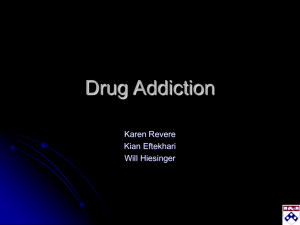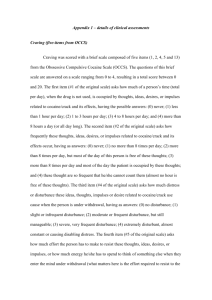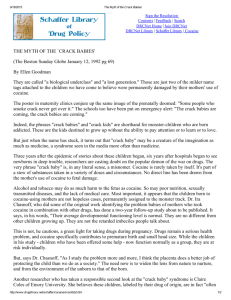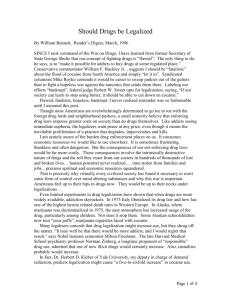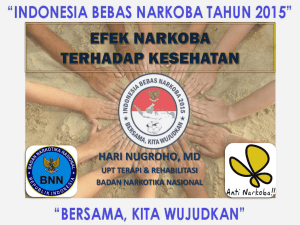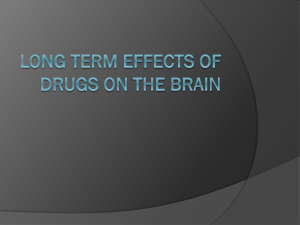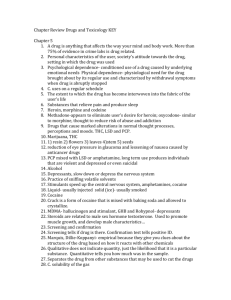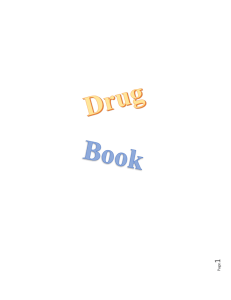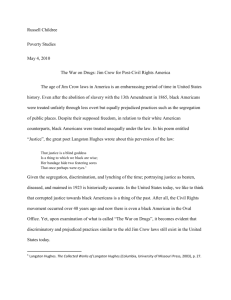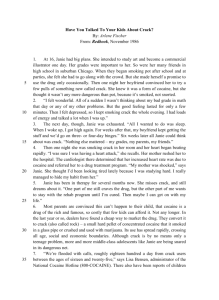Carl Hart`s TED Talk Transcript
advertisement
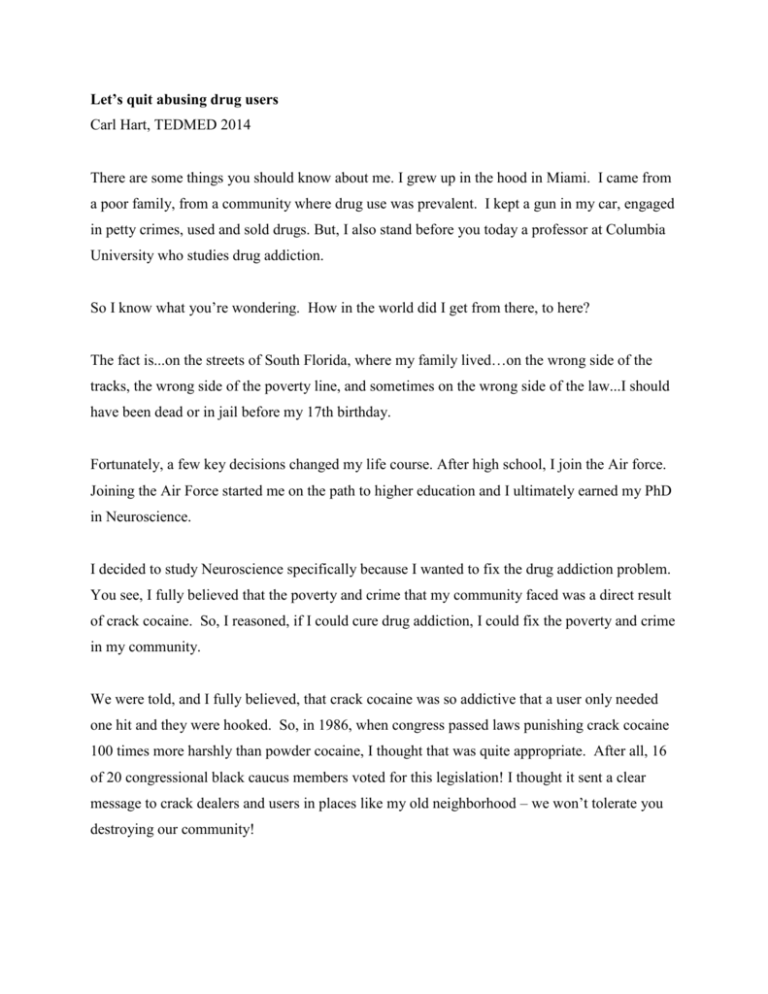
Let’s quit abusing drug users Carl Hart, TEDMED 2014 There are some things you should know about me. I grew up in the hood in Miami. I came from a poor family, from a community where drug use was prevalent. I kept a gun in my car, engaged in petty crimes, used and sold drugs. But, I also stand before you today a professor at Columbia University who studies drug addiction. So I know what you’re wondering. How in the world did I get from there, to here? The fact is...on the streets of South Florida, where my family lived…on the wrong side of the tracks, the wrong side of the poverty line, and sometimes on the wrong side of the law...I should have been dead or in jail before my 17th birthday. Fortunately, a few key decisions changed my life course. After high school, I join the Air force. Joining the Air Force started me on the path to higher education and I ultimately earned my PhD in Neuroscience. I decided to study Neuroscience specifically because I wanted to fix the drug addiction problem. You see, I fully believed that the poverty and crime that my community faced was a direct result of crack cocaine. So, I reasoned, if I could cure drug addiction, I could fix the poverty and crime in my community. We were told, and I fully believed, that crack cocaine was so addictive that a user only needed one hit and they were hooked. So, in 1986, when congress passed laws punishing crack cocaine 100 times more harshly than powder cocaine, I thought that was quite appropriate. After all, 16 of 20 congressional black caucus members voted for this legislation! I thought it sent a clear message to crack dealers and users in places like my old neighborhood – we won’t tolerate you destroying our community! But, I was unprepared for what I would learn as I made my own contribution to understanding the neuroscience of drug addiction. And, what that meant for how I viewed the role of drugs in the poverty-and-crime cycle. I first began to question my thinking when I discovered that drugs like crack cocaine are not as addictive as I had been told. There is no drug in which one hit will make you an addict. The data clearly show, 80-90% of people who use drugs do not have a ‘drug problem’! They are responsible members of our society. They are employed; they pay taxes; they take care of their families. And in some cases, they even become President of the United States (show photo of last three U.S. Presidents). All three of these men reported using illegal drugs when they were younger. The point is not to tarnish the reputations of these men -- they all served their country. My point is that their drug use did not result in an inevitable downward spiral leading to debauchery and addiction. And the experience of these men is the rule, not the exception -- the overwhelming majority of drug users are not derelict addicts. The basis for the “one hit and you are hooked” idea comes from experiments done in the 1960s and 70s. Laboratory animals - when allowed unlimited access to drugs like cocaine and methamphetamine – will press a lever repeatedly to receive intravenous injections until it kills them. These early experiments confirm drug-seeking-until-death. But, that is not the whole story. The cages of these animals, in the experiments I just mentioned, only contained a lever that led to intravenous drug injections – nothing else. The most interesting part to me, however, was what happened when the animals were presented with a choice between the drug lever and non-drug alternatives such as toys, sexually receptive mates, or sweet treats. When given any other option, animals do not self-administer drugs until death. In fact, animals will often choose non-drug alternatives over drugs! In my own lab, I followed up on these findings using human participants. We recruited ‘crack addicts’ from the streets of NYC. By the way, my use of the term addict conforms to the DSM definition of substance use disorder. And, importantly, we met all necessary human subjects and regulatory requirements before initiating these experiments. We brought crack users into the lab and offered them $5 cash or a hit of crack worth more than $5. We repeated this many times with each person over several days in the lab. The drug users chose the drug about half of the time, and the $5 the other half. Even a nominal amount of money was enough to deter them from taking the drug at least half of the time. Not exactly the insane, “anything for a hit” behavior that I had been taught crack addicts would display. Then, we recruited methamphetamine users and conducted the same experiment. The MA users also chose drug about half of the time and $5 about half of the time. Next, we raised the cash reward to $20. When $20 was the alternative to MA, the users never took the drug. They always chose money. Just like the animals – when given an attractive alternative, even people diagnosed with drug addiction did not choose drugs. Stated another way, attractive alternatives decrease drug use! This is definitely not the result I expected when I set out to ‘solve the drug addiction problem’. Since my time in the hood, I had always viewed the plight of my family and community through the lens of “those bad drugs”. I perpetuated the narrative that drugs were the problem. So you can imagine my shock and confusion as I started to uncover evidence that crime and poverty are mostly independent of drug use. Crime was present in poor communities well before crack cocaine hit the streets. And, annual FBI crime statistics show that the overwhelming majority of prisoners are not intoxicated or addicted during the time of their crime. As I think back over my family situation growing up – it is clear that my family was poor before drugs ever entered the picture. And I certainly engaged in petty crime but it had nothing to do with drug addiction –it was about money and status. In other words, if you take drug use out of the equation, crime and poverty still exist. It is not drug addiction driving people to commit crimes; it is other factors. To make matters worse, drug laws are not uniformly enforced across all parts of our society – and this perpetuates the cycle of poverty and crime. The popular view is that people in poor, black communities use crack cocaine, while powder cocaine tends to be used in white communities with more resources. Federal laws passed in 1986 & 1988 established punishments for crack cocaine possession 100 times more harshly than powder cocaine. Scientifically, this makes no sense. Crack and powder cocaine are the same drug; and they both have predictable pharmacological effects -- as the dose of either is increased, so are the effects on blood pressure, heart rate, euphoria, addictive potential, you name it. It is true that the effects of smoking crack cocaine tend to be more intense than swallowing or snorting powder cocaine– but that increased intensity is due to route of administration, not the drug itself. Injecting powder cocaine dissolved in water produces nearly identical intense effects as smoking crack cocaine. And, those same laws require a minimum prison sentence of at least 5 years for people caught with even small amounts of crack, but not so with powder cocaine. But here is the injustice -80% of the people convicted under these laws were black, despite the fact that most users of all forms of cocaine are white. This kind of selective targeting and racial discrimination contributes to the horrifying statistic that one in three black boys born today is projected to spend time in prison. The same number for white boys is about one in 20. So, what do we do about this? We can do at least three things that will have an immediate positive impact. First, my research shows that attractive alternatives can decrease drug use. Because meaningful employment is one of the most attractive alternative reinforcers, providing viable economic opportunities will go a long way in decreasing drug abuse. Second, I believe we should decriminalize all drug possession offenses. This means treating drug possession like a traffic violation. One might be required to pay a fine if caught with illegal drugs, but would not be subject to criminal prosecution. When you consider that each year we arrest 1.5 million people for drug law violations, and 80% of these arrests are for simple possession – decriminalization of possession would have a huge effect. Countries, such as Portugal and the Czech Republic, have already decriminalized drugs. Rates of drug use in those countries are similar or better than their EU neighbors. But under decriminalization, significant portions of their citizens are not stigmatized, marginalized, and unfairly incarcerated. If our goal in the US is to have a fair and just legal system that treats all portions of our society equally, then we must change the criminalization and selective enforcement of drug laws. Third, I believe science should be driving our drug policies, even if it makes us feel uncomfortable. The first step is being honest about drug use. We can dramatically decrease the number of people who die from recreational drug use. How? Better education. Real education campaigns that teach people how to prevent drug overdoses instead of histrionic and inaccurate “This is your brain on drugs” images. Here’s one simple example: 75% of heroin-related deaths occur because heroin was combined with another sedative such as alcohol or a benzo. Educational/Public Health message – IF YOU ARE GOING TO USE HEROIN DON’T COMBINE IT WITH A SEDATIVE!! People have always used drugs and will continue to use drugs. We need to learn to live with this fact. Our society already takes this approach with other potentially dangerous activities such as sex and alcohol and even driving. I’ve come a long way from the mean streets of Miami. And I’ve come an equally long way from that starry-eyed young man who wanted to eradicate drugs as the best way to solve crime and poverty. Today, I no longer want to eliminate drugs – that would be naïve. Please don’t misunderstand me; I still want to help people with drug problems. Equally important, I also want to keep safe recreational users who don’t have a problem because they make up the majority of drug users. What I now know, however, is that the drugs themselves are not the problem. The real problems are poverty, unemployment, selective drug law enforcement, ignorance and the dismissal of science that surrounds these drugs. As a scientist, I am doing my best to lessen the ignorance by disseminating the science. I hope you will join me. Thank you.
